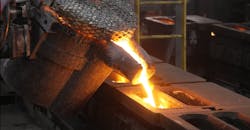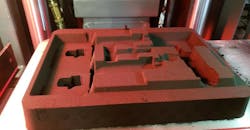Quality iron castings are the result of quality processes, in every stage of production, starting with mold design. Foundries that prioritize precision from coremaking phase through the final pour realize fewer defects, better metallurgical consistency, and increased efficiency across production. For metalcasting professionals, this is not just a matter of operational preference; it’s a principal strategy for competitiveness and sustainability.
Iron castings face rigorous performance demands, from wear resistance to dimensional precision. While alloy selection and furnace control receive plenty of attention, mold design just as important in achieving these outcomes. A poor mold does not just compromise shape or surface finish; it invites defects like shrinkage, gas porosity, misruns, and cold shuts. Often these issues can be traced back not to the metal but to how it has been guided, fed, cooled, and vented within the mold.
Successful foundries treat mold design as an integrated process. Understanding the thermal, fluid, and structural interactions within the mold is key to producing consistently high-quality castings.
Getting internal geometry right
Cores are more than placeholders for hollow sections. They are precision components with direct influence on casting success. Core design and placement should account for:
- Core strength and gas generation: Weak cores or those made from volatile binders may collapse or emit gases that create porosity. Using low-gas binders and curing methods tailored to the casting's complexity will help to mitigate this.
- Ventilation and permeability: Without proper venting, core gases cannot escape. Strategic vent placement, especially in intricate cavities, prevents trapped air pockets and blowholes.
- Core alignment: Misaligned cores distort internal features and weaken walls. Tooling aids like core prints and chaplets must hold the core firmly during pouring.
Optimizing gating systems
The gating system is the first opportunity to influence how molten metal enters the mold cavity. Proper gating balances velocity, temperature, and turbulence. Design flaws here ripple through the entire casting.
Among the key principles of gating are:
- Minimize turbulence: Excessive velocity or sharp turns introduce air and oxide inclusions. Use tapered sprues, choke points, and smooth transitions to preserve laminar flow.
- Temperature retention: Long or complex gating paths lead to metal cooling before it reaches the cavity. Heated runners or insulated gates can offset these losses.
- Directional solidification: Feed metal into thicker sections first and design the gating path to fill the mold uniformly, preventing cold shuts and misruns.
Risers and feeders
Iron castings contract as they cool. Without a liquid reservoir — or riser — to feed the contracting metal, shrinkage cavities form. Proper riser design ensures volume compensation and improves internal soundness. An overlooked but vital factor is riser size: too small and it starves the casting; too large and it wastes material and energy. Best practices for risers include:
- Hotspot targeting: Position risers at thick cross-sections that solidify last. Software-based solidification models help identify these areas.
- Riser insulation: Using exothermic or insulating sleeves slows riser solidification, ensuring molten metal is available when the casting needs it most.
- Riser neck geometry: The connection between the riser and casting must freeze off last. Tapered or notched necks optimize this behavior while minimizing post-processing effort.
Strategic chilling
In iron casting, not all parts of the mold should cool at the same rate. Uneven cooling can lead to undesirable microstructures, especially in gray or ductile iron. Chills — heat-absorbing inserts made from iron, copper, or graphite — accelerate solidification in targeted areas. Chills must be carefully integrated into the mold design, both mechanically and thermally. Poor placement can induce thermal stresses or unwanted gradients. Use chills to:
- Promote directional solidification, steering solidification fronts toward risers.
- Refine microstructures in critical areas for better wear resistance.
- Prevent hot spots that lead to shrinkage or porosity.
Venting systems let molds breathe
Even the best cores and molds release gases during pouring. If those gases are not given a clear escape route, they become trapped — creating blowholes, surface blisters, or even incomplete fills. Venting design must be tailored to the binder type, casting volume, and geometry, especially in low-draft or thin-wall areas. Effective venting strategies include:
- Integrated vents: Fine wire mesh, vent rods, or porous inserts embedded in the mold cavity.
- Parting line vents: Thin slits along the mold joint allow gases to escape without affecting the casting contour.
- Vacuum assist: In high-complexity castings, vacuum venting may be used to draw out gases before the metal arrives.
Advancing quality with digital simulation
Modern foundries increasingly rely on casting simulation software to analyze and refine mold designs before physical production. These tools can model:
- Metal flow and turbulence
- Solidification patterns
- Shrinkage and riser performance
- Gas generation and venting efficiency
Simulation reduces trial-and-error iterations, and it promotes more consistent outcomes and faster time to production. Even smaller foundries benefit from digital tools through partnerships with design consultants or shared software services, reducing the cost barrier.
Elevating outcomes with integrated design
Mold design is an interplay of multiple factors. Poor gating can negate a perfect core; weak venting can sabotage an otherwise sound riser. The highest-quality iron castings emerge when the full mold system is treated holistically.
Foundries aiming to improve yield, reduce scrap, and shorten cycle times must look upstream into the mold itself to find answers. Combining practical experience with data-driven insights enables teams to troubleshoot faster and cast smarter.
Iron casting is both art and engineering, and better mold design bridges the two. From core geometry to vent routing, each decision influences not only whether a casting “works,” but how well it performs in service. As demands for higher strength, tighter tolerances, and lower scrap rates grow, so too must the sophistication of mold design.
Technologies like shell mold casting are helping foundries take a step further, offering smoother surfaces, precise tolerances, and better dimensional accuracy for complex geometries. When paired with optimized gating and feeding strategies, such approaches enable foundries to push quality boundaries without compromising efficiency.
Ultimately, better castings don’t begin at the furnace — they begin at the mold. When foundries make mold design a strategic focus, the results speak for themselves: fewer defects, happier customers, and a more agile operation prepared for tomorrow’s challenges.
About the Author
Eric Wozniak
Vice President, Sales
Eric Wozniak is Vice President of Sales at Hiler Industries, a supplier of cast metal components manufactured by the shell molding process.


